Abstract
The assessment of the diagnostic power of four serum tumour markers, CEA, CA 19-9, CA 50 and CA 195 for colorectal carcinoma is described, according to recently formulated guidelines. Preoperative serum concentrations of the four markers were determined in 198 colorectal cancer patients and 57 patients with a benign colorectal disorder. The cumulative frequency distributions of the malignant and benign group show strong overlap for all markers, which indicates low diagnostic ability. This is confirmed by the Receiver Operating Characteristic curves, which have areas under the curve of 0.65 (95% confidence interval (CI) 0.58-0.73) for CA 19-9, CA 50 and CA 195 and of 0.70 (95%) CI 0.63-0.77) for CEA. The new tumour markers appear to be of slightly less diagnostic value than CEA for the primary diagnosis of colorectal cancer, although the discrepancy is not statistically significant. The low diagnostic power of CA 19-9, CA 50 and CA 195 may be due to a high proportion of colorectal cancer patients having the Lewis(a-b-) phenotype, who cannot synthesise these markers.
Full text
PDF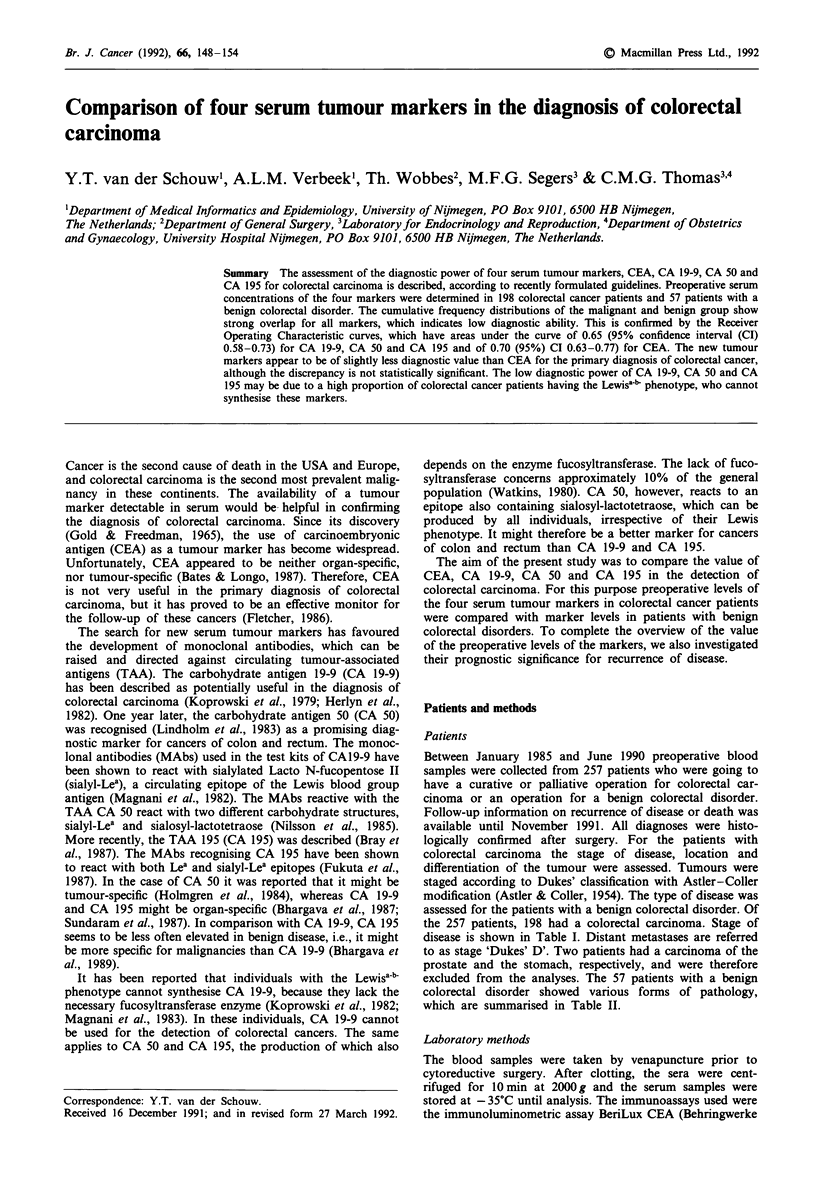
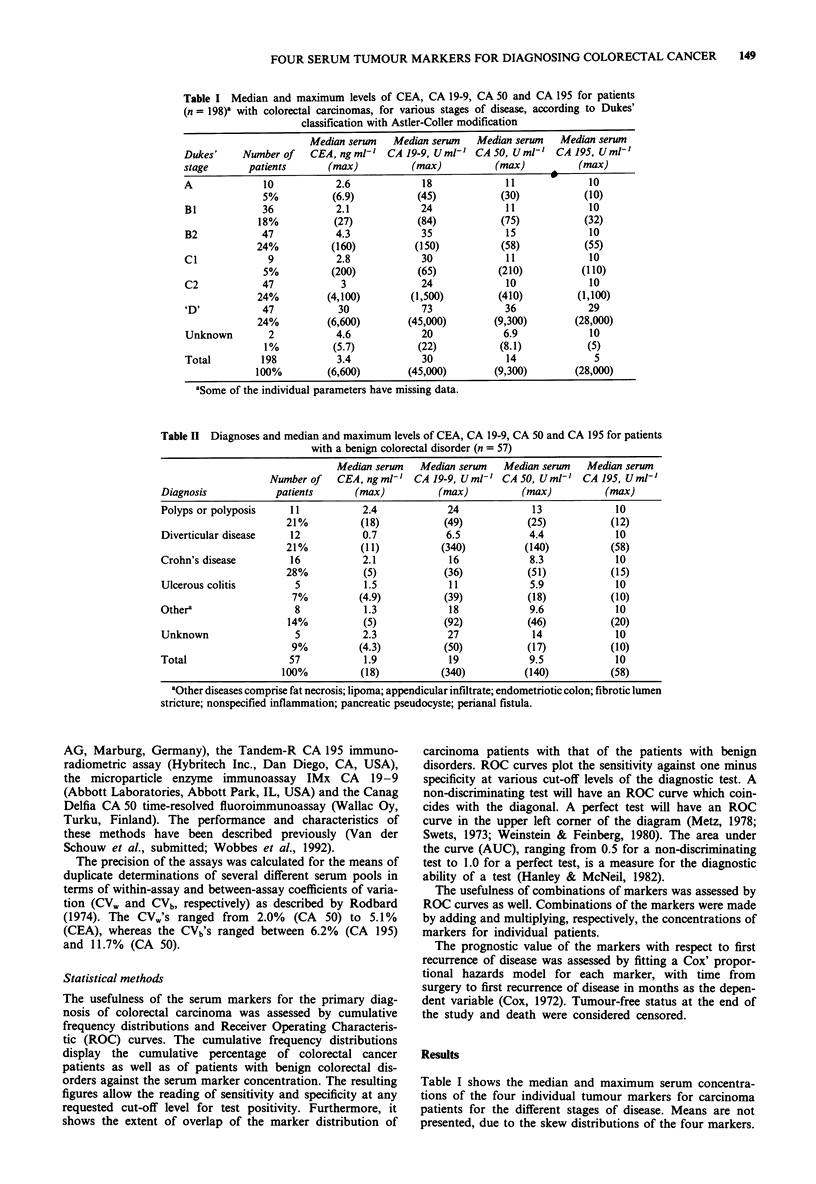
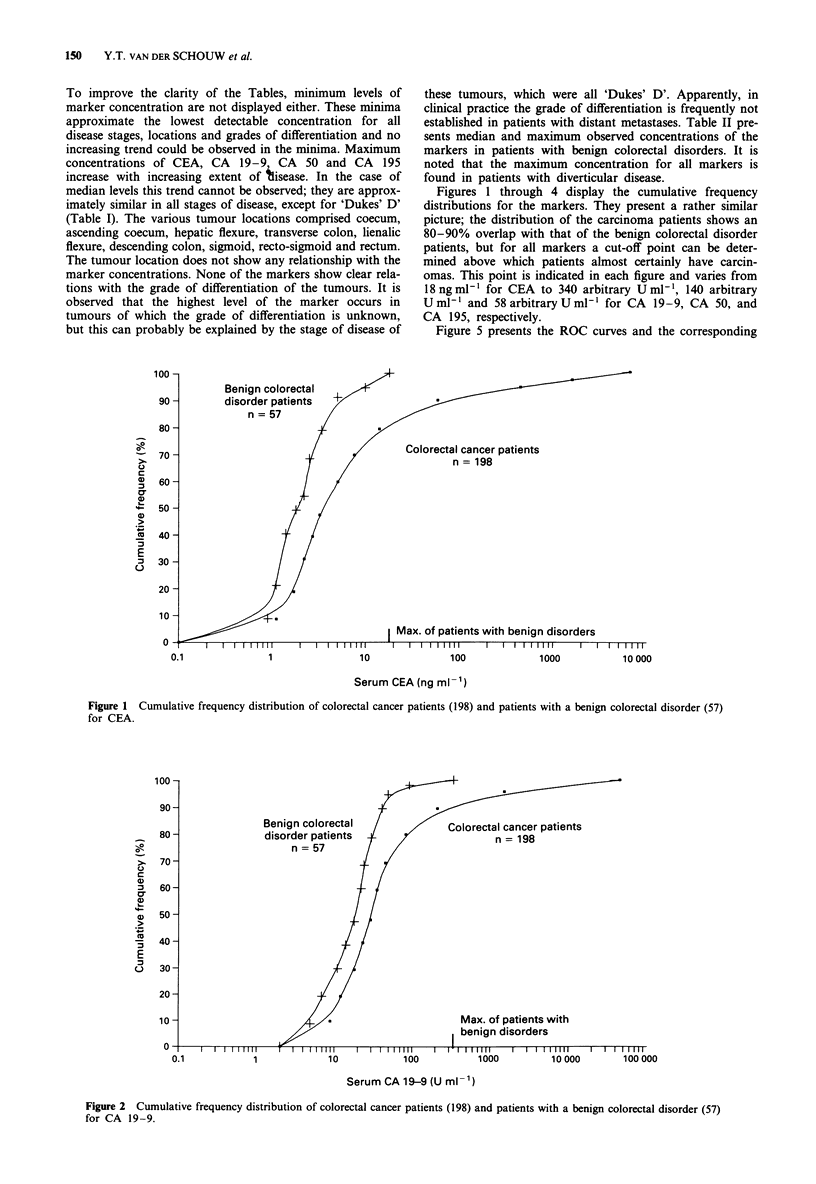
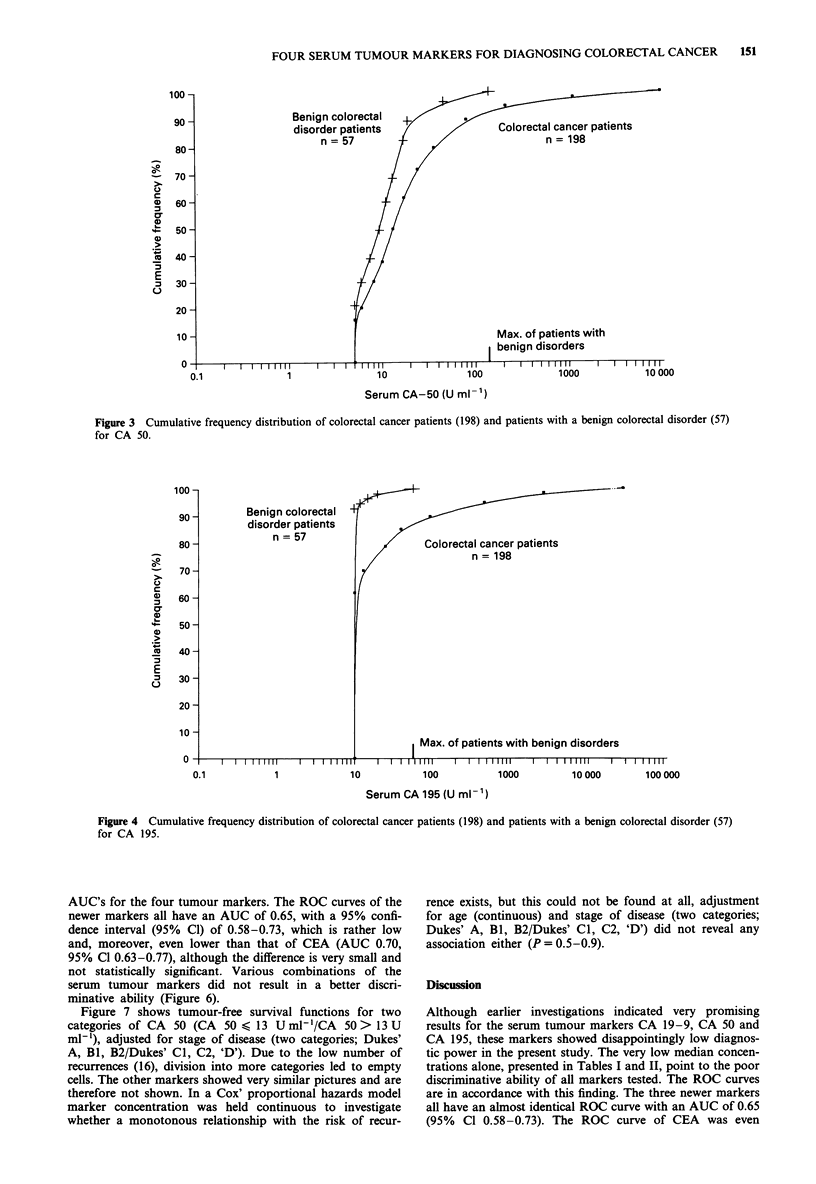
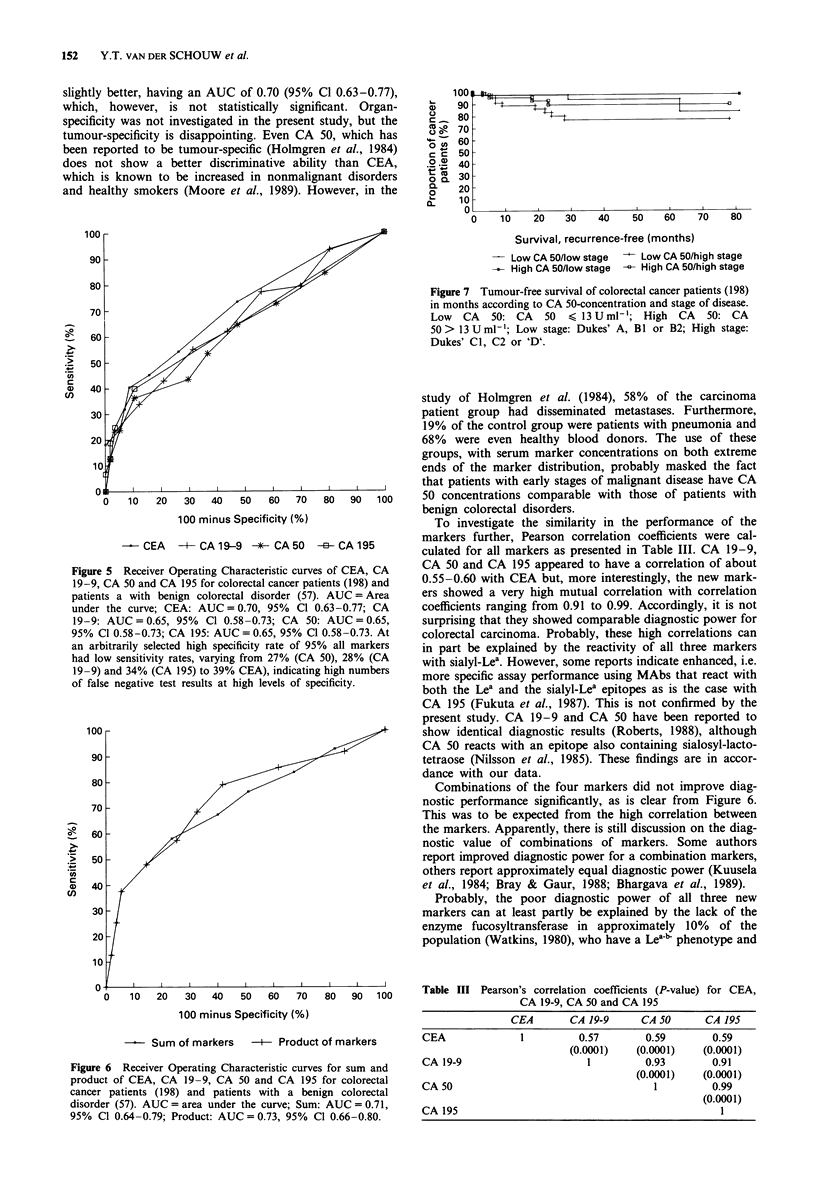

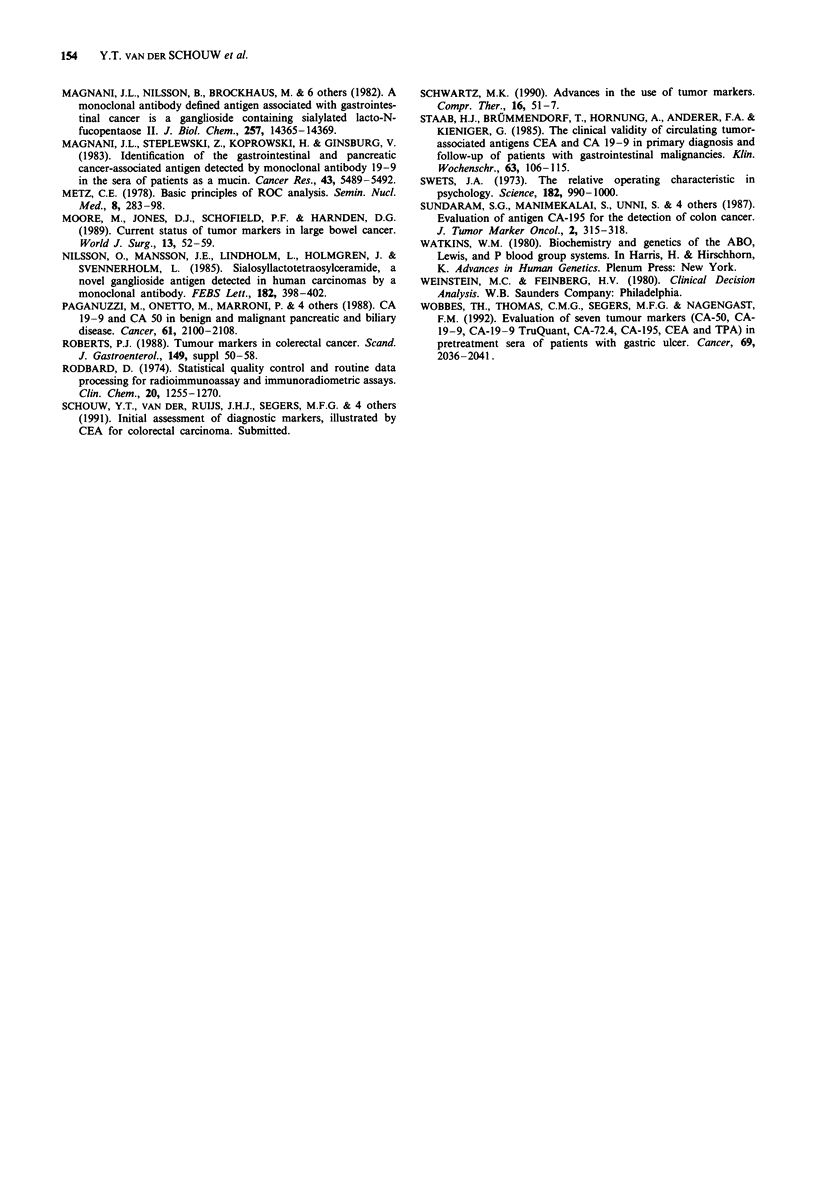
Selected References
These references are in PubMed. This may not be the complete list of references from this article.
- ASTLER V. B., COLLER F. A. The prognostic significance of direct extension of carcinoma of the colon and rectum. Ann Surg. 1954 Jun;139(6):846–852. doi: 10.1097/00000658-195406000-00015. [DOI] [PMC free article] [PubMed] [Google Scholar]
- Bates S. E., Longo D. L. Use of serum tumor markers in cancer diagnosis and management. Semin Oncol. 1987 Jun;14(2):102–138. [PubMed] [Google Scholar]
- Bhargava A. K., Petrelli N. J., Karna A., Parshall P. L., Fitzpatrick J. E., Douglass H. O., Herrera L., Bray K., Gaur P. Serum levels of cancer-associated antigen CA-195 in gastrointestinal cancers and its comparison with CA19-9. J Clin Lab Anal. 1989;3(6):370–377. doi: 10.1002/jcla.1860030610. [DOI] [PubMed] [Google Scholar]
- Fletcher R. H. Carcinoembryonic antigen. Ann Intern Med. 1986 Jan;104(1):66–73. doi: 10.7326/0003-4819-104-1-66. [DOI] [PubMed] [Google Scholar]
- Fukuta S., Magnani J. L., Gaur P. K., Ginsburg V. Monoclonal antibody CC3C195, which detects cancer-associated antigens in serum, binds to the human Lea blood group antigen and to its sialylated derivative. Arch Biochem Biophys. 1987 May 15;255(1):214–216. doi: 10.1016/0003-9861(87)90314-6. [DOI] [PubMed] [Google Scholar]
- GOLD P., FREEDMAN S. O. DEMONSTRATION OF TUMOR-SPECIFIC ANTIGENS IN HUMAN COLONIC CARCINOMATA BY IMMUNOLOGICAL TOLERANCE AND ABSORPTION TECHNIQUES. J Exp Med. 1965 Mar 1;121:439–462. doi: 10.1084/jem.121.3.439. [DOI] [PMC free article] [PubMed] [Google Scholar]
- Hanley J. A., McNeil B. J. The meaning and use of the area under a receiver operating characteristic (ROC) curve. Radiology. 1982 Apr;143(1):29–36. doi: 10.1148/radiology.143.1.7063747. [DOI] [PubMed] [Google Scholar]
- Herlyn M., Sears H. F., Steplewski Z., Koprowski H. Monoclonal antibody detection of a circulating tumor-associated antigen. I. Presence of antigen in sera of patients with colorectal, gastric, and pancreatic carcinoma. J Clin Immunol. 1982 Apr;2(2):135–140. doi: 10.1007/BF00916897. [DOI] [PubMed] [Google Scholar]
- Hirano K., Kawa S., Oguchi H., Kobayashi T., Yonekura H., Ogata H., Homma T. Loss of Lewis antigen expression on erythrocytes in some cancer patients with high serum CA19-9 levels. J Natl Cancer Inst. 1987 Dec;79(6):1261–1268. [PubMed] [Google Scholar]
- Holmgren J., Lindholm L., Persson B., Lagergård T., Nilsson O., Svennerholm L., Rudenstam C. M., Unsgaard B., Yngvason F., Pettersson S. Detection by monoclonal antibody of carbohydrate antigen CA 50 in serum of patients with carcinoma. Br Med J (Clin Res Ed) 1984 May 19;288(6429):1479–1482. doi: 10.1136/bmj.288.6429.1479. [DOI] [PMC free article] [PubMed] [Google Scholar]
- Koprowski H., Brockhaus M., Blaszczyk M., Magnani J., Steplewski Z., Ginsburg V. Lewis blood-type may affect the incidence of gastrointestinal cancer. Lancet. 1982 Jun 12;1(8285):1332–1333. doi: 10.1016/s0140-6736(82)92402-3. [DOI] [PubMed] [Google Scholar]
- Koprowski H., Steplewski Z., Mitchell K., Herlyn M., Herlyn D., Fuhrer P. Colorectal carcinoma antigens detected by hybridoma antibodies. Somatic Cell Genet. 1979 Nov;5(6):957–971. doi: 10.1007/BF01542654. [DOI] [PubMed] [Google Scholar]
- Kuusela P., Jalanko H., Roberts P., Sipponen P., Mecklin J. P., Pitkänen R., Mäkelä O. Comparison of CA 19-9 and carcinoembryonic antigen (CEA) levels in the serum of patients with colorectal diseases. Br J Cancer. 1984 Feb;49(2):135–139. doi: 10.1038/bjc.1984.25. [DOI] [PMC free article] [PubMed] [Google Scholar]
- Langkilde N. C., Wolf H., Meldgård P., Orntoft T. F. Frequency and mechanism of Lewis antigen expression in human urinary bladder and colon carcinoma patients. Br J Cancer. 1991 Apr;63(4):583–586. doi: 10.1038/bjc.1991.135. [DOI] [PMC free article] [PubMed] [Google Scholar]
- Lindholm L., Holmgren J., Svennerholm L., Fredman P., Nilsson O., Persson B., Myrvold H., Lagergård T. Monoclonal antibodies against gastrointestinal tumour-associated antigens isolated as monosialogangliosides. Int Arch Allergy Appl Immunol. 1983;71(2):178–181. doi: 10.1159/000233384. [DOI] [PubMed] [Google Scholar]
- Magnani J. L., Nilsson B., Brockhaus M., Zopf D., Steplewski Z., Koprowski H., Ginsburg V. A monoclonal antibody-defined antigen associated with gastrointestinal cancer is a ganglioside containing sialylated lacto-N-fucopentaose II. J Biol Chem. 1982 Dec 10;257(23):14365–14369. [PubMed] [Google Scholar]
- Magnani J. L., Steplewski Z., Koprowski H., Ginsburg V. Identification of the gastrointestinal and pancreatic cancer-associated antigen detected by monoclonal antibody 19-9 in the sera of patients as a mucin. Cancer Res. 1983 Nov;43(11):5489–5492. [PubMed] [Google Scholar]
- Metz C. E. Basic principles of ROC analysis. Semin Nucl Med. 1978 Oct;8(4):283–298. doi: 10.1016/s0001-2998(78)80014-2. [DOI] [PubMed] [Google Scholar]
- Moore M., Jones D. J., Schofield P. F., Harnden D. G. Current status of tumor markers in large bowel cancer. World J Surg. 1989 Jan-Feb;13(1):52–59. doi: 10.1007/BF01671154. [DOI] [PubMed] [Google Scholar]
- Nilsson O., Månsson J. E., Lindholm L., Holmgren J., Svennerholm L. Sialosyllactotetraosylceramide, a novel ganglioside antigen detected in human carcinomas by a monoclonal antibody. FEBS Lett. 1985 Mar 25;182(2):398–402. doi: 10.1016/0014-5793(85)80341-0. [DOI] [PubMed] [Google Scholar]
- Paganuzzi M., Onetto M., Marroni P., Barone D., Conio M., Aste H., Pugliese V. CA 19-9 and CA 50 in benign and malignant pancreatic and biliary diseases. Cancer. 1988 May 15;61(10):2100–2108. doi: 10.1002/1097-0142(19880515)61:10<2100::aid-cncr2820611028>3.0.co;2-z. [DOI] [PubMed] [Google Scholar]
- Roberts P. J. Tumour markers in colorectal cancer. Scand J Gastroenterol Suppl. 1988;149:50–58. doi: 10.3109/00365528809096956. [DOI] [PubMed] [Google Scholar]
- Rodbard D. Statistical quality control and routine data processing for radioimmunoassays and immunoradiometric assays. Clin Chem. 1974 Oct;20(10):1255–1270. [PubMed] [Google Scholar]
- Schwartz M. K. Advances in the use of tumor markers. Compr Ther. 1990 Nov;16(11):51–57. [PubMed] [Google Scholar]
- Staab H. J., Brümmendorf T., Hornung A., Anderer F. A., Kieninger G. The clinical validity of circulating tumor-associated antigens CEA and CA 19-9 in primary diagnosis and follow-up of patients with gastrointestinal malignancies. Klin Wochenschr. 1985 Feb 4;63(3):106–115. doi: 10.1007/BF01734248. [DOI] [PubMed] [Google Scholar]
- Swets J. A. The Relative Operating Characteristic in Psychology: A technique for isolating effects of response bias finds wide use in the study of perception and cognition. Science. 1973 Dec 7;182(4116):990–1000. doi: 10.1126/science.182.4116.990. [DOI] [PubMed] [Google Scholar]
- Wobbes T., Thomas C. M., Segers M. F., Nagengast F. M. Evaluation of seven tumor markers (CA 50, CA 19-9, CA 19-9 TruQuant, CA 72-4, CA 195, carcinoembryonic antigen, and tissue polypeptide antigen) in the pretreatment sera of patients with gastric carcinoma. Cancer. 1992 Apr 15;69(8):2036–2041. doi: 10.1002/1097-0142(19920415)69:8<2036::aid-cncr2820690805>3.0.co;2-m. [DOI] [PubMed] [Google Scholar]


